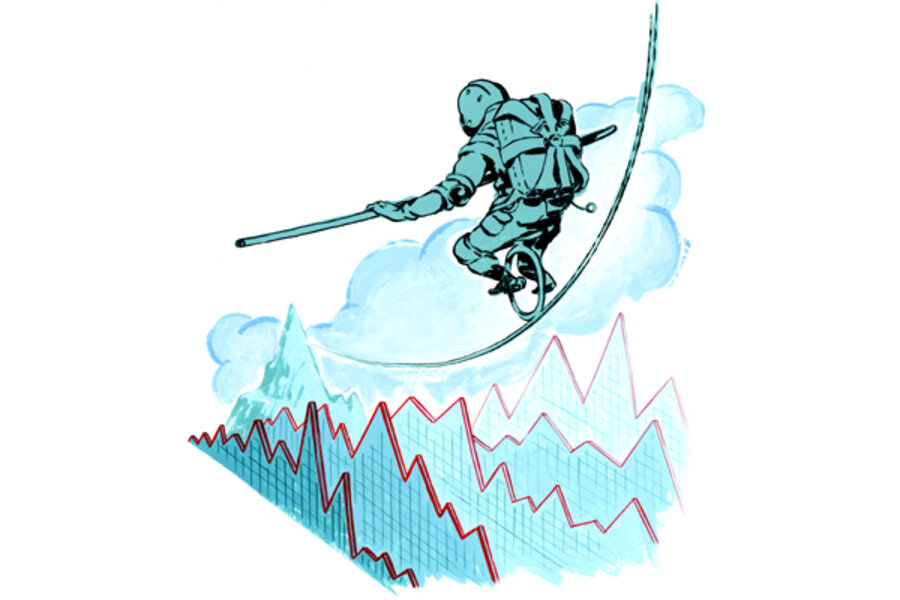Don't avoid investment risk. Control it.
Loading...
It's coming to be known as the "lost decade" for the American stock market. From 2000 through 2009, the stock market as measured by the Standard & Poor's 500 index fell an average 2.6 percent a year. Things haven't improved much since then. For the 12-year period through the end of 2011, the S&P index returned a paltry 0.5 percent a year.
Could it be that the stock market is too risky to invest in anymore? After the dot-com bubble of the early 2000s and especially after Wall Street's collapse during the 2008 financial crisis, the market has taken a roller-coaster ride. With so much risk, it's no wonder fewer Americans say they're invested in stocks than at any time since Gallup began asking the question in 1998.
Nevertheless, stocks still have the most reliable long-term track record of any mainstream investment for growing a portfolio, proponents say. There is greater reward for those who take on reasonable risks in stocks. The key is to control it.
Investment risk comes in different forms. There's market risk – the danger that the market suddenly plunges because of fears about the European debt concerns, US elections, or for no apparent reason at all. There's company risk – the possibility that specific stocks will lose value because of poor management or an unforeseen company- or industry-specific problem. Then there's inflation risk, which slowly eats away at investment returns.
"This is sort of a silent killer," says Simon Roy, executive vice president of corporate development at Jemstep, an online investment guide and source of advice. "One of the biggest risks is that investors take what they think is a conservative approach and they put their money in cash or just in bonds, because they think that's the safest thing to do. And they barely beat inflation."
But you can mitigate some of these risks using various tools. The first tool, suggested by legendary investor Benjamin Graham more than 60 years ago, is diversification. Don't put all your eggs in the stock market. Buy some bonds or other less volatile investment.
You can vary the diversification depending on the risk you want to take on. A 30-year-old, eager for growth, might put 70 percent of her money in stocks and 30 percent in bonds. An older investor might use a 50-50 split.
Buying lots of stocks – or mutual funds or exchange-traded funds that invest in dozens or hundreds of companies – also reduces the risks if any one company fails.
The second tool is allocation, which is really diversifying your portfolio, especially your stock holdings, in a specific manner. Decades of academic research suggest that diversified investors who buy some large-company stocks (less risky) and small-company issues (more risky), some US companies (less risky) and some foreign ones (more risky) generate bigger returns with less volatility than those who buy in just one area. They do even better if they allocate some money to so-called growth stocks (companies with growing earnings) and value stocks (companies that are worth more than their stock price). Allocation "to me is the single most important thing to get right," Mr. Roy says.
It's not enough to buy these stocks and bonds: You have to rebalance them periodically, say, two or four times a year. At the end of the period, if your stocks go up in value, you switch some of the money to bonds to get back to your original stock-bond split. And if your large-company stocks outperform your international holdings, move money to get back to your original allocation. This discipline forces investors to buy stocks when they're low and sell them when they're high.
This classic approach to investing, known as modern portfolio theory, has many detractors. Diversification didn't work during the 2008 panic since almost all stocks fell sharply. And those long-term steady returns from stocks turn out to be the average of two highly different periods, says Ed Easterling, author of "Probable Outcomes" and founder of Crestmont Holdings, an investment management and research firm in Oregon.
If you invested when stocks were undervalued, such as the early '80s, your portfolio did much better than the 10 percent or so annual average. If you invested when stocks were overvalued, it took years and sometimes decades to approach that return.
But the bigger danger may be letting the fear of risk keep you from investing in stocks at all. With a diversified stock and bond portfolio – rebalanced once a year and with the stock portion allocated among mutual funds invested in small and large US companies, overseas firms in developed and emerging markets, US real estate, and commodities – you would have done fairly well since 2000, Roy calculates. It didn't matter whether you were aggressive (85 percent in stocks) or conservative (37 percent in stocks), your returns would have averaged anywhere from 5 percent to 6.1 percent a year, according to Roy's calculations, far better than the 0.5 percent from the S&P and with less risk.
So $100,000, invested in the aggressive portfolio in 2000, would be worth $180,000 by the end of 2011; the conservative portfolio, $203,500.
Not bad for a lost decade.








